
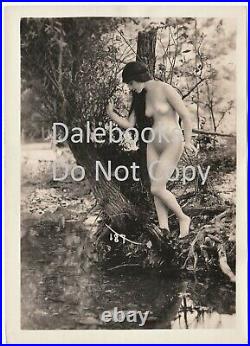
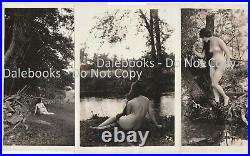
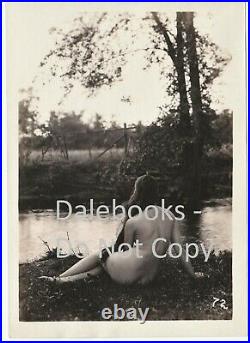
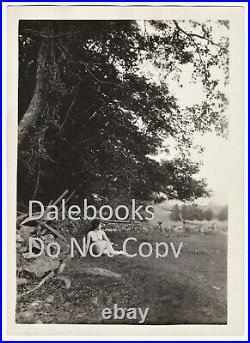
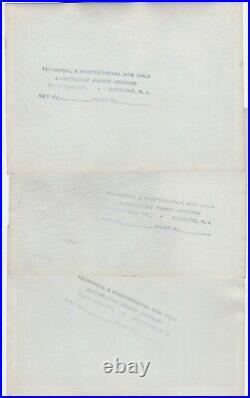

Series / Set of 3. Each 5 x 7 inches. For offer – a nice old photo lot! Fresh from an estate in Upstate Western NY. Never offered on the market until now. Vintage, Old, antique, Original – NOT a Reproduction – Guaranteed!! Same model in each photo. On back : Rembrandt Photo Studies, Bayonne, N. Silver gelatin – high quality original black and white photos. 5 x 7 inches each. In very good to excellent condition. If you collect American photography, 19th century history, Americana, advertisement ad, etc. This is a nice one for your paper or ephemera collection. Charles Wesley Gilhousen (born in Kahoka, Missouri March 19, 1867 – died November 29, 1929 in Des Moines, Iowa), American photographer. Photography is a genre of fine-art photography which depicts the nude human body with an emphasis on form, composition, emotional content, and other aesthetic qualities. The nude has been a prominent subject of photography since its invention, and played an important role in establishing photography as a fine art medium. The distinction between fine art photography and other subgenres is not absolute, but there are certain defining characteristics. Erotic interest, although often present, is secondary, [1] which distinguishes art photography from both glamour photography, which focuses on showing the subject of the photograph in the most attractive way, and pornographic photography, which has the primary purpose of sexually arousing the viewer. Fine art photographs are also not taken to serve any journalistic, scientific, or other practical purpose. The distinction between these is not always clear, and photographers, as with other artists, tend to make their own case in characterizing their work, [2][3][4] though the viewer may have a different assessment. The nude remains a controversial subject in all media, but more so with photography due to its inherent realism. [5] The male nude has been less common than the female, and more rarely exhibited or published. Photography and the Traditional Arts. Photograph by Jean Louis Marie Eugène Durieu, part of a series made with Eugène Delacroix. Odalisque (1857) by Eugène Delacroix (Oil on panel), a painting with similar pose. Gaudenzio Marconi made his living supplying académies to students at the École des beaux-arts in Paris. Adam and Eve by Frank Eugene, taken 1898, published in Camera Work no. Nude by Gaudenzio Marconi, 18411885. Guglielmo Plüschow Male nude. Wilhelm von Gloeden, Two male nudes outdoors c1900. Those early photographers in Western cultures who sought to establish photography as a fine art medium, frequently chose women as the subjects for their nude photographs, in poses that accorded with traditional nudes in other media. Before nude photography, art nudes usually used allusions to classical antiquity; gods and warriors, goddesses and nymphs. Depictions of male and female nudes in traditional art mediums had been mostly limited to portrayals as an ideal warrior or athlete (for men) or that emphasized divinity and reproduction (for women), [7] and early photographic art first engaged these archetypes as well. Poses, lighting, soft focus, vignetting and hand retouching were employed to create photographic images that rose to the level of art comparable to the other arts at that time. [5] The main limitation was that early photographs were monochrome. Although 19th century artists in other media often used photographs as substitutes for live models, the best of these photographs were also intended as works of art in their own right. Nude photography was more controversial than painted nude works, and in order to avoid censorship some early nude photographs were described as “studies for artists”, [5] while others were used as references by artists to do drawings and paintings as a supplement to live models. Eugène Delacroix was an early adopter of the practice of using photographs taken specifically for him by his friend, Eugène Durieu. [8] Edgar Degas made his own photographs that he used for painting references. [9] Thomas Eakins used photography for studies of several of his paintings The Swimming Hole as an example. Georgia OKeeffe, Hands and Breasts (1919) by Alfred Stieglitz. Nude study by Rudolf Koppitz (1927). As fine art photography first embraced and then moved passed classical allegorical imagery, both male and female photographers began to use the male nude as another medium to examine issues of representation and identity, sexuality and voyeurism. Photographing nudes (and particularly male nudes) became a way for women artists to engage the subject of the nude from the position of power traditionally reserved for male artists;[12] alternatively, nude self-portraiture allowed men to begin to re-evaluate accepted definitions of sensuality and masculinity by photographing themselves. Alfred Stieglitz is a major figure in bringing modern art to America by exhibiting the new genre of art in his New York galleries at the beginning of the 20th century. He is known to the public perhaps more for his relationship with Georgia O’Keeffe, whose nude photos he exhibited in 1921 while married to someone else. [14] Stieglitz used the camera as a kind of mirror. My photographs,’ he wrote in 1925,’are ever born of an inner need–an Experience of Spirit. I do not make pictures. I have a vision of life and I try to find equivalents for it sometimes in the form of photographs. Often he would write of true seeing and of inness. As O’Keeffe noted rightly, the man she knew so well was’always photographing himself. Imogen Cunningham began taking photographs in Seattle in 1905, in the soft-focused pictorialist style popular at that time; but she is best known for the sharp-focused modern style she developed later. She is also attributed as the first woman photographer to take a nude photo of a man (her husband, Roi Partridge). [16] In the work of Judy Dater, one particular photo, Imogen and Twinka, became one of the most recognizable images caught by an American photographer. It features a 91 year old Imogen Cunningham and a nude Twinka Thiebaud. [17] The photo was the first adult full frontal nude photograph published in Life magazine, in 1976. After World War I, avant-garde photographers became more experimental in their portrayal of nudity, using reflective distortions and printing techniques to create abstractions or depicting real life rather than classical allusions. Beginning in the late 1920s Man Ray experimented with the Sabattier, or solarization process, a technique that won him critical esteem, especially from the Surrealists. Many of the central figures of SurrealismBreton, Magritte, Dalífollowed his example in using photography in addition to other media. Other photographers, such as Maurice Tabard and Raoul Ubac, were directly inspired by Man Rays techniques, while photographers such as André Kertész and Brassaï were indirectly influenced by his innovative approach to the medium. Edward Weston evolved a particularly American aesthetic, using a large format camera to capture images of nature and landscapes as well as nudes, establishing photography as a fine arts medium. [19] In 1937 Weston became the first photographer to be awarded a John Simon Guggenheim Memorial Fellowship. [20] For a famous example of Weston’s work see: Charis Wilson. Bill Brandt is best known for a series of nudes developed primarily between 1945 and 1961, that are both personal and universal, sensual and strange, collectively exemplifying the sense of wonder that is paramount in his photographs. Brandts work is unpredictable not only in the range of his subjects but also in his printing style, which varied widely throughout his career. This exhibition is the first to emphasize the beauty of Brandts finest prints, and to trace the arc of their evolution. Many fine art photographers have a variety of subjects in their work, the nude being one. Diane Arbus was attracted to unusual people in unusual settings, including a nudist camp. Lee Friedlander had more conventional subjects, one being Madonna as a young model. Further information: Ruth Bernhard, Harry Callahan (photographer), and Emmet Gowin. Equus 1989 by Sergio Valle Duarte. Nudes (1980) by Augusto De Luca. Re-reading of The Dream of the Fisherman’s Wife 1988, by Sergio Valle Duarte. Kargaltsev posed nude on rocks (2012) by Alexander Kargaltsev. For some, the difference is in the gaze of the model, with glamour models looking into the camera, while art models do not. Glamour and fashion photographers have aspired to fine art status in some of their work. One of the first was Irving Penn, who progressed from Vogue magazine to photographing fashion models such as Kate Moss nude. Richard Avedon, Helmut Newton and Annie Leibovitz[25] have followed a similar path with portraits of the famous, many of them nude. [26] or partially clothed. [27] In the post-modern era, where fame is often the subject of fine art, [28] Avedon’s photo of Nastassja Kinski with a python, and Leibovitz’s magazine covers of Demi Moore pregnant and in body paint, have become iconic. The work of Joyce Tenneson has gone the other way, from fine art with a unique, soft-focus style showing woman at all stages of life to portraiture of famous people and fashion photography. Although nude photographers have largely worked within established forms that show bodies as sculptural abstractions, some, such as Robert Mapplethorpe, have created works that deliberately blur the boundaries between erotica and art. Several photographers have become controversial because of their nude photographs of underage subjects. [30] David Hamilton often used erotic themes, [31] but Jock Sturges celebrates the beauty of people in naturist settings without emphasis on sexuality. [32][33] Sally Mann was raised in rural Virginia, in a locale where skinny-dipping in a river was common, so many of her most famous photographs are of her own children swimming in the nude. [34] Less well-known photographers have been charged as criminals (but not convicted) for photos of their own children. Body image has become a topic explored by many photographers working with models whose bodies do not conform to conventional prejudices about beauty. At the beginning of the 21st century, it has become difficult to make an artistic statement in nude photography, given the proliferation of non-artistic and pornographic images which taints the subject in the perception of most viewers, limiting the opportunities to exhibit or publish the images. When they appear in mainstream consumer magazines such as Popular Photography, PC Photo, and Shutterbug; the editors receive sufficient negative response that they tend to reject the work of serious nude-image photographers. Body image has become a topic explored by many photographers working with models who do not conform to conventional ideas about beauty. Leonard Nimoy, after many years photographing conventionally beautiful professional models, realized that he was not capturing individual personalities, so he created a series with women interested in “Fat Liberation”. [36] Sally Mann’s more recent nudes have been of her husband, whose body shows the effects of muscular dystrophy. Many contemporary artists push the boundaries by having work with both aesthetic qualities and explicit sexuality. Late in his life Robert Mapplethorpe created work that was controversial in part by being on display in Washington, DC in a gallery receiving public funds. [48] When a Mapplethorpe retrospective opened at the Cincinnati Contemporary Arts Center in 1990, Dennis Barrie became the first American museum director to be criminally prosecuted for the contents of an exhibition. Although explicit photos were placed in a separate room with a content warning, Barrie was charged with “pandering obscenity” and showing minors in a state of nudity, but a jury acquitted Barrie and the Arts Center of all charges. The nude figure is a tradition in Western art, and has been used to express ideals of male and female beauty and other human qualities. Athletes, dancers, and warriors are depicted to express human energy and life, and nudes in various poses may express basic or complex emotions such as pathos. [2] In one sense, a nude is a work of fine art that has as its primary subject the unclothed human body, [3] forming a subject genre of art, in the same way as landscapes and still life. Unclothed figures often also play a part in other types of art, such as history painting, including allegorical and religious art, portraiture, or the decorative arts. Nude female figures called Venus figurines are found in the art of the Upper Palaeolithic, and in historical times, similar images represent fertility deities. [4] Representations of gods and goddesses in Babylonian and Ancient Egyptian art are the precursors of the works of Western antiquity. Other significant non-Western traditions of depicting nudes come from India, and Japan, but the nude does not form an important aspect of Chinese art. Temple sculptures and cave paintings, some very explicit, are part of the Hindu tradition of the value of sexuality, and as in many warm climates partial or complete nudity was common in everyday life. Japan had a tradition of mixed communal bathing that existed until recently, and was often portrayed in woodcut prints. See also: Ancient Greek sculpture. The earliest Greek sculpture, from the early Bronze Age Cycladic civilization consists mainly of stylized male figures who are presumably nude. This is certainly the case for the kouros, a large standing figure of a male nude that was the mainstay of Archaic Greek sculpture. The first realistic sculptures of nude males, the kouroi depict nude youths who stand rigidly posed with one foot forward. [5] By the 5th century BCE, Greek sculptors’ mastery of anatomy resulted in greater naturalness and more varied poses. An important innovation was contrappostothe asymmetrical posture of a figure standing with one leg bearing the body’s weight and the other relaxed. An early example of this is Polykleitos’ sculpture Doryphoros ca. In the convention of heroic nudity, gods and heroes were shown nude, while ordinary mortals were less likely to be so, though athletes and warriors in combat were often depicted nude. In Ancient Greece, where the mild climate was conducive to being lightly-clothed or nude whenever convenient, and male athletes competed at religious festivals entirely nude, and celebrated the human body, it was perfectly natural for the Greeks to associate the male nude form with triumph, glory, and even moral excellence. [6] The Greek goddess Aphrodite was a deity whom the Greeks preferred to see clothed. In the mid-fourth century BCE, the sculptor Praxiteles made a nude Aphrodite, called the Knidian, which established a new tradition for the female nude, having idealized proportions based on mathematical ratios as were the nude male statues. The nudes of Greco-Roman art are conceptually perfected ideal persons, each one a vision of health, youth, geometric clarity, and organic equilibrium. Kenneth Clark considered idealization the hallmark of true nudes, as opposed to more descriptive and less artful figures that he considered merely naked. His emphasis on idealization points up an essential issue: seductive and appealing as nudes in art may be, they are meant to stir the mind as well as the passions. Middle Ages and Renaissance. The Birth of Venus by Sandro Botticelli. Venus and the Lute Player (15651570) by Titian. Christian attitudes cast doubt on the value of the human body, and the Christian emphasis on chastity and celibacy further discouraged depictions of nakedness, even in the few surviving Early Medieval survivals of secular art. Completely unclothed figures are rare in medieval art, the notable exceptions being Adam and Eve and the damned in Last Judgement scenes, and the ideal forms of Greco-Roman nudes are completely lost, transformed into symbols of shame and sin, weakness and defenselessness. [8] This was true not only in Western Europe, but also in Byzantine art. [9] Increasingly, Christ was shown largely naked in scenes of his Passion, especially the Crucifixion, [10] and even when glorified in heaven, to allow him to display the wounds his sufferings had involved. The Nursing Madonna and naked “Penitent Mary Magdalene”, as well as the infant Jesus, whose penis was sometimes emphasized for theological reasons, are other exceptions with elements of nudity in medieval religious art. By the late medieval period female nudes intended to be attractive edged back into art, especially in the relatively private medium of the illuminated manuscript, and in classical contexts such as the Signs of the Zodiac and illustrations to Ovid. The shape of the female “Gothic nude” was very different from the classical ideal, with a long body shaped by gentle curves, a narrow chest and high waist, small round breasts, and a prominent bulge at the stomach (as in the Hugo van der Goes at left). [11] Male nudes tended to be slim and slight in figure, probably drawing on apprentices used as models, but were increasingly accurately observed. The rediscovery of classical culture in the Renaissance restored the nude to art. Donatello made two statues of the Biblical hero David, a symbol for the Republic of Florence: his first (in marble, 14081409) shows a clothed figure, but his second, probably of the 1440s, is the first freestanding statue of a nude since antiquity, [12] several decades before Michelangelo’s massive David (150104). Nudes in Michelangelo’s Sistine Chapel ceiling reestablished a tradition of male nudes in depictions of Biblical stories; the subject of the martyrdom of the near-naked Saint Sebastian had already become highly popular. The Dresden Venus of Giorgione c. 1510, also drawing on classical models, showed a reclining female nude in a landscape, beginning a long line of famous paintings including the Venus of Urbino (Titian, 1538), the Rokeby Venus Diego Velázquez, c. 1650, Goya’s Nude Maja c. 1798 and Manet’s Olympia (1863). Although they reflect the proportions of ancient statuary, such figures as Titian’s Venus and the Lute Player and Venus of Urbino highlight the sexuality of the female body rather than its ideal geometry. In addition to adult male and female figures, the classical depiction of Eros became the model for the naked Christ child. Raphael in his later years is usually credited as the first artist to consistently use female models for the drawings of female figures, rather than studio apprentices or other boys with breasts added, who were previously used. Michelangelo’s suspiciously boyish Study of a Kneeling Nude Girl for The Entombment Louvre, c. 1500, which is usually said to be the first nude female figure study, predates this and is an example of how even figures who would be shown clothed in the final work were often worked out in nude studies, so that the form under the clothing was understood. The nude figure drawing or figure study of a live model rapidly became an important part of artistic practice and training, and remained so until the 20th century. The Three Graces (16361638) by Peter Paul Rubens. See also: Judgement of Paris, The Raft of the Medusa, Le déjeuner sur l’herbe, The Toilette of Esther, and The Swimming Hole. In Baroque art, the continuing fascination with classical antiquity influenced artists to renew their approach to the nude, but with more naturalistic, less idealized depictions, perhaps more frequently working from live models. [4] Both genders are represented; the male in the form of heroes such as Hercules and Samson, and female in the form of Venus and the Three Graces. Peter Paul Rubens, who with evident delight painted women of generous figure and radiant flesh, gave his name to the adjective rubenesque. In the later Baroque or Rococo period, a more decorative and playful style emerged, exemplified by François Boucher’s Venus Consoling Love, likely commissioned by Madame Pompadour. In the eighteenth and nineteenth centuries, classical subjects remained popular, along with nudes in historical paintings. In the later nineteenth century, academic painters continued with classical themes, but were challenged by the Impressionists. Eduard Manet shocked the public of his time by painting nude women in contemporary situations in his Le Déjeuner sur l’herbe (1863) and Olympia (1865), and Gustave Courbet earned criticism for portraying in his Woman with a Parrot a naked prostitute without vestige of goddess or nymph. Edgar Degas painted many nudes of women in ordinary circumstances, such as taking a bath. [14] Auguste Rodin challenged classical canons of idealization in his expressively distorted Adam. [15] With the invention of photography, artists began using the new medium as a source for paintings, Eugène Delacroix being one of the first. Nu (Nu debout) (1911) by Jean Metzinger. Sculpture of a Woman Standing by Gaston Lachaise, 1932. Standing Woman (1932) by Gaston Lachaise. Although both the Academic tradition and Impressionists lost their cultural supremacy at the beginning of the twentieth century, the nude remained although transformed by the ideas of modernism. The idealized Venus was replaced by the woman intimately depicted in private settings, as in the work of Egon Schiele. [4] The simplified modern forms of Jean Metzinger, Amedeo Modigliani, Gaston Lachaise and Aristide Maillol recall the original goddesses of fertility more than Greek goddesses. [16] In early abstract paintings, the body could be fragmented or dismembered, as in Picasso’s Demoiselles d’Avignon, but there are also abstracted versions of classical themes, such as Henri Matisse’s dancers and bathers. In the post-WWII era, Abstract Expressionism moved the center of Western art from Paris to New York City. One of the primary influences in the rise of abstraction, the critic Clement Greenberg, had supported de Kooning’s early abstract work. Although having some references to the traditions of single female figures, the women were portrayed as voracious, distorted, and semi-abstract. According to the artist, he wanted to “create the angry humor of tragedy”; having the frantic look of the atomic age, a world in turmoil, a world in need of comic relief. Later, he said Maybe… I was painting the woman in me. Art isn’t a wholly masculine occupation, you know. I’m aware that some critics would take this to be an admission of latent homosexuality… If I painted beautiful women, would that make me a non-homosexual? I like beautiful women. In the flesheven the models in magazines. Women irritate me sometimes. I painted that irritation in the Woman series. Such ideas could not be expressed by pure abstraction alone. [17] Some critics, however, see the Woman series as misogynistic. Other New York artists of this period retained the figure as their primary subject. Alice Neel painted nudes, including her own self-portrait, in the same straightforward style as clothed sitters, [19] being primarily concerned with color and emotional content. [20] Philip Pearlstein uses unique cropping and perspective to explore the abstract qualities of nudes. As a young artist in the 1950s, Pearlstein exhibited both abstracts and figures, but it was deKooning that advised him to continue with figurative work. Around 1970, from feminist principles, Sylvia Sleigh painted a series of works reversing stereotypical artistic themes by featuring naked men in poses usually associated with women. Benefits Supervisor Sleeping (1995). I paint people, not because of what they are like, not exactly in spite of what they are like, but how they happen to be. Lucien Freud[23]. Lucien Freud was one of a small group of painters which included Francis Bacon who came to be known as “The School of London”; creating figurative work in the 1970s when it was unfashionable. [24] However, by the end of his life his works had become icons of the Post Modern era, depicting the human body without a trace of idealization, as in his series working with an obese model. [25] One of Freud’s works is entitled “Naked Portrait”, which implies a realistic image of a particular unclothed woman rather than a conventional nude. [26] In Freud’s obituary in The New York Times, it is stated: His “stark and revealing paintings of friends and intimates, splayed nude in his studio, recast the art of portraiture and offered a new approach to figurative art”. The paintings of Jenny Saville include family and self-portraits among other nudes; often done in extreme perspectives, attempting to balance realism with abstraction; all while expressing how a woman feels about the female nude. [28] Lisa Yuskavage’s nude figures painted in a nearly academic manner constitute a “parody of art historical nudity and the male obsession with the female form as object”. [29] John Currin is another painter whose work frequently reinterprets historic nudes. [30] Cecily Brown’s paintings combine figurative elements and abstraction in a style reminiscent of de Kooning. [31] Marlene Dumas paints emotionally challenging images derived from her own snapshots or from photographs found in news magazines. [32] Dumas says of her paintings of nude figures that it was not the nude I was looking for, nor the posing figure, but the erotic conditions of life… Two’subjects’ confronting each other. The end of the twentieth century saw the rise of new media and approaches to art, although they began much earlier. In particular installation art often includes images of the human body, and performance art frequently includes nudity. “Cut Piece” by Yoko Ono was first performed in 1964 (then known as a “happening”). Audience members were requested to come on stage and begin cutting away her clothing until she was nearly naked. Several contemporary performance artists such as Marina Abramovi, Vanessa Beecroft and Carolee Schneemann use their own nude bodies or other performers in their work. The item “SUPERB Set of 3 Orig Photos 1920 Beautiful Nude Woman Outdoors C W Gilhousen” is in sale since Sunday, January 5, 2020. This item is in the category “Art\Art Photographs”. The seller is “dalebooks” and is located in Rochester, New York. This item can be shipped worldwide.
- Size: Small (up to 12in.)
- Region of Origin: North America
- Style: Art Nouveau
- Listed By: Dealer or Reseller
- Date of Creation: 1900-1949
- Color Type: Black & White
- Year: 1920
- Width (Inches): 5
- Photo Type: Gelatin Silver
- Subject: Nudes
- Originality: Original
- Height (Inches): 7
- Theme: Risqué

